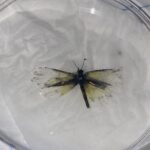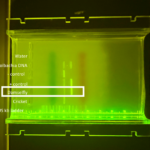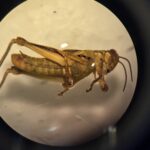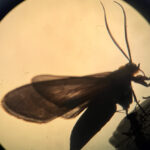Sample information |
|
| Picture |

|
|---|---|
| Location | |
| Collection date | 09/09/2023 |
| Captive / Cultivated? | Wild-caught |
| Group | Palm Beach Atlantic University |
| Observations | Arthropod was found in a grassy area in a field of a park in Florida during a sunny morning. |
| Putative identification | Arthropoda Insecta Odonata |
Methods |
|
| Extraction kit | DNeasy (Qiagen) |
| DNA extraction location | Abdomen |
| Single or Duplex PCR | Single Reaction |
| Gel electrophoresis system | Standard electrophoresis system |
| Buffer | TAE |
| DNA stain | GelGreen |
| Gel images |

|
| Protocol notes | DNA Extraction: The abdomen of the damselfly was cut from its body then crushed really well in order to extract its DNA. Gel electrophoresis Lanes: The wells of the gel were loaded in the following order (assuming lanes are shown on the left in the picture) 8- empty 7- Water (negative control) 6- + DNA control PCR control 5- -Arthropod PCR/ DNA extraction control 4- +Arthropod DNA extraction control 3- damselfly 2- cricket 1- 1 kb plus DNA ladder Analysis: There were bands in all lanes except water confirming that our DNA extraction and PCR techniques worked as they should. All of the controls also showed their expected bands. |
Results |
|
| Wolbachia presence | Yes |
| Confidence level | High |
| Explanation of confidence level | Im very confident that my results are accurate. All of my controls worked as expected and the protocol was followed very closely. We ensured to work efficiently and carefully to avoid any cross contamination that could’ve occurred. |
| Wolbachia 16S sequence | |
| Arthropod COI sequence |
|
| Summary | The Odonata was found to be postive for Wolbachia. |
 Differential Grasshopper – Melanoplus differentialis
Differential Grasshopper – Melanoplus differentialis Pill Bug (Armadillidium vulgare) – Draft
Pill Bug (Armadillidium vulgare) – Draft Melanoplus Femurrubrum
Melanoplus Femurrubrum Grasshopper – Orthoptera
Grasshopper – Orthoptera Cisseps Fulvicollis
Cisseps Fulvicollis